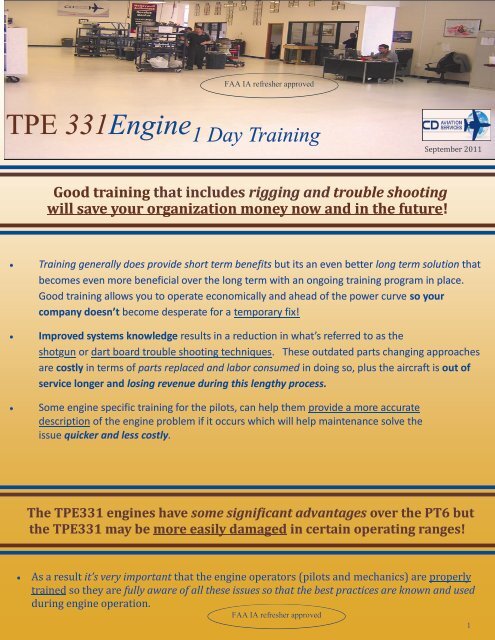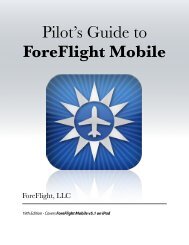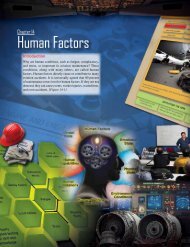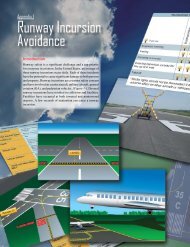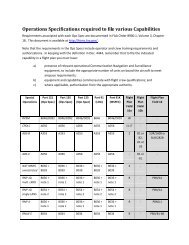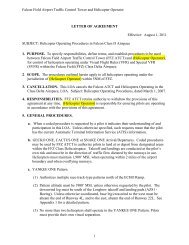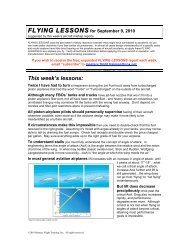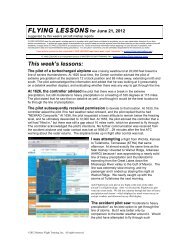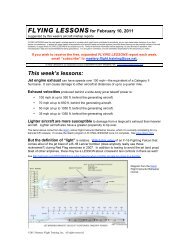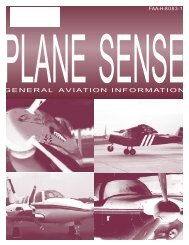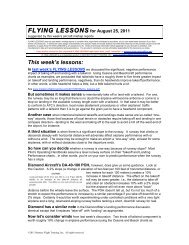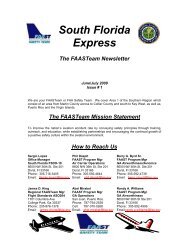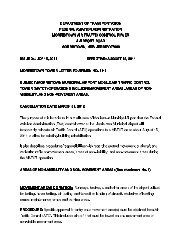TPE 331Engine - FAASafety.gov
TPE 331Engine - FAASafety.gov
TPE 331Engine - FAASafety.gov
Create successful ePaper yourself
Turn your PDF publications into a flip-book with our unique Google optimized e-Paper software.
FAA IA refresher approved<br />
<strong>TPE</strong> <strong>331Engine</strong><br />
1 Day Training<br />
September 2011<br />
Good training that includes rigging and trouble shooting<br />
will save your organization money now and in the future!<br />
Training generally does provide short term benefits but its an even better long term solution that<br />
becomes even more beneficial over the long term with an ongoing training program in place.<br />
Good training allows you to operate economically and ahead of the power curve so your<br />
company doesn’t become desperate for a temporary fix!<br />
Improved systems knowledge results in a reduction in what’s referred to as the<br />
shotgun or dart board trouble shooting techniques. These outdated parts changing approaches<br />
are costly in terms of parts replaced and labor consumed in doing so, plus the aircraft is out of<br />
service longer and losing revenue during this lengthy process.<br />
Some engine specific training for the pilots, can help them provide a more accurate<br />
description of the engine problem if it occurs which will help maintenance solve the<br />
issue quicker and less costly.<br />
The <strong>TPE</strong>331 engines have some significant advantages over the PT6 but<br />
the <strong>TPE</strong>331 may be more easily damaged in certain operating ranges!<br />
As a result it’s very important that the engine operators (pilots and mechanics) are properly<br />
trained so they are fully aware of all these issues so that the best practices are known and used<br />
during engine operation.<br />
FAA IA refresher approved<br />
1
FAA IA refresher approved<br />
<strong>TPE</strong> <strong>331Engine</strong> 1 Day Training<br />
September 2011<br />
You must have a plan during all engine starts. That includes having your hand on the stop<br />
switch or the manual emergency shutdown lever as required during starts and be<br />
prepared to act promptly if required.<br />
You can’t take your eye off the temperature gauge during start.<br />
You can’t take your eye off the RPM gauge during starts within the (18 to 28% RPM) critical<br />
range!<br />
Don’t put off fixing problems that result in weak starter energy. Issues such as a bad starter,<br />
low batteries, a weak power cart and etc, can damage your engine.<br />
Closely monitor every start, day after day, if a change occurs and it’s too slow or too hot,<br />
don’t put it off and continue to operate. Fix it!<br />
Higher powered aircraft start systems such as the Fast Start System, high voltage power<br />
carts or external battery carts are beneficial and make the engine less likely to have<br />
start problems.<br />
The CD Aviation 1 day training class consists of over 200 colored slides via a<br />
power point presentation and each student will get their own<br />
personal colored training manual to take home.<br />
FAA IA refresher approved<br />
2
FAA IA refresher approved<br />
<strong>TPE</strong> <strong>331Engine</strong> 1 Day Training<br />
September 2011<br />
The training material covered expands<br />
upon the subject material listed below.<br />
CD overview<br />
<strong>TPE</strong> History<br />
Airflows<br />
Horsepower<br />
Free turbine design<br />
Fixed shaft design<br />
Start procedures<br />
Cockpit troubleshooting<br />
Fuel nozzle maintenance<br />
Carbon erosion<br />
Cost savings<br />
Engine description<br />
Fuel consumption<br />
Cost comparison<br />
Engine power<br />
EGT / ITT systems<br />
Power runs<br />
Beta and PG modes<br />
The training material includes many student<br />
questions and the class participation during the<br />
open forum class structure results in an<br />
enhanced learning experience for those in<br />
attendance.<br />
Upon completion the students will be awarded<br />
a certificate. The material is FAA<br />
IA refresher approved and CD<br />
Aviation Services is a Honeywell<br />
Authorized Service Center.<br />
Trainer background:<br />
I completed my 4 year USAF tour of duty followed by<br />
A&P training at Spartan in Tulsa, Oklahoma and subsequently<br />
obtained my A&P license in June of 1972. My<br />
general aviation experience since obtaining my license<br />
is now at 39 years and counting. During this interval I<br />
have had some involvement with other engine models<br />
but the majority of my experience has been on the<br />
<strong>TPE</strong>331 engine series.<br />
I have held numerous positions over the years including<br />
mechanic, lead man, crew chief, engine shop manager,<br />
factory field service engineer; parts brokerage<br />
Garret engine program manager, maintenance sales<br />
manager and maintenance training manager.<br />
I believe my long and varied background gives me the<br />
technical experience necessary to provide the customized<br />
training required for your personnel on the<br />
<strong>TPE</strong>331 engine models. Over the years I have learned<br />
the value of good, easy to understand communication<br />
which I believe I am able to utilize during this maintenance<br />
training. I look forward to working with you on<br />
your training needs in the future.<br />
Regards,<br />
Mike Straus<br />
Customer Training Manager<br />
E-mail mike.straus@cdaviationservices.com<br />
417.499.9152<br />
3
A<br />
FAA IA refresher approved<br />
<strong>TPE</strong> <strong>331Engine</strong> 1 Day Training<br />
September 2011<br />
Sample of 12 Training Manual Slides<br />
Constant Speed Operation<br />
Constant Speed Operation continued<br />
In a constant speed (fixed shaft<br />
engine) the propeller pitch or prop<br />
load plus the load from the<br />
compressor section together must<br />
offset by the turbine section power<br />
output.<br />
The balance between turbine<br />
section power output and the<br />
load applied by the compressor<br />
section and the prop pitch must<br />
be equal to result in a fixed<br />
power and speed setting.<br />
1000 HP 2000 HP<br />
COMPRESSOR IMPELLERS AND<br />
PROP PITCH LOADS MUST!<br />
3000 HP<br />
= TURBINE POWER OUTPUT!<br />
<strong>TPE</strong>331 Line Maintenance Course - Section I<br />
35<br />
<strong>TPE</strong>331 Line Maintenance Course - Section I<br />
36<br />
Otter<br />
-12 ENGINE ON (CDAS JOPLIN) TEST CELL<br />
A lebow is used to determine what the real torque is at the<br />
prop via the lebow digital torque readout and what the<br />
torque sensor pressures (raw delta P) are at these various<br />
lebow indicated power levels.<br />
Lebow<br />
<strong>TPE</strong>331 Line Maintenance Course - Section I<br />
49<br />
<strong>TPE</strong>331 Line Maintenance Course - Section I 56<br />
Air flow stations continued<br />
Beta and PG Modes of Operation<br />
T4<br />
T4.1<br />
POWER LEVERS (PL)<br />
PG (FLIGHT)<br />
FUEL<br />
CONDITION LEVERS (CL)<br />
PITCH<br />
PG<br />
Woodward fuel control rigging<br />
mock up used during the 1 week<br />
line maintenance training class.<br />
P5-T5<br />
FI<br />
BETA (GROUND)<br />
PITCH<br />
FUEL<br />
USFG<br />
REV<br />
• The position of the power lever establishes the mode of operation.<br />
P1-T1<br />
P2-T2<br />
P3-T3<br />
• When the power lever is between flight idle and full reverse (red range) it establishes the<br />
BETA (ground) mode of operation.<br />
• When the power lever is between flight idle and max (blue range) it establishes the PROP<br />
GOVERNOR (flight) mode of operation.<br />
<strong>TPE</strong>331 Line Maintenance Course - Section I<br />
20<br />
<strong>TPE</strong>331 Line Maintenance Course - Section I<br />
74<br />
<strong>TPE</strong>331 Line Maintenance Course - Section I<br />
79<br />
FAA IA refresher approved<br />
4
FAA IA refresher approved<br />
<strong>TPE</strong> <strong>331Engine</strong> 1 Day Training<br />
September 2011<br />
Sample of Training Questions<br />
If your engine reads 650 degrees at the T4 limit will you be allowed to adjust the<br />
compensator from min to max comp?<br />
With the SRL tuned off what is the EGT limit?<br />
What is the EGT limit on start? What is the SRL limit on takeoff?<br />
If your -10 engine has a temp limiter what value would you expect it to limit at?<br />
Why does the limiter system not prevent an engine over temp during a start?<br />
What effect would a low FI blade angle have on FI power in flight?<br />
What could cause the AC to float on landing? In some cases what do pilots attempt<br />
if this does occurr?<br />
On takeoff the PL adds fuel and pitch? (T or F)<br />
What controls prop pitch in flight?<br />
Could a failed (negative or pos) EGT compensator result in an engine exceeding the<br />
T4 limit?<br />
On manual enrich starts when should enrich first be actuated?<br />
FAA IA refresher approved<br />
5


